The following is a guest post by Robin Butterhof, a Digital Conversion Specialist in the Serial and Government Publications Division. The following interview is with Toben Traver from Dartmouth Libraries in Hanover, NH.
Since 2007, the Chronicling America* collection of digitized historic newspapers has grown through the contributions of state partners participating in the National Digital Newspaper Program (NDNP). The collection now contains over 21 million pages from more than 4,000 newspaper titles.
Dartmouth College joined the NDNP in 2022 as the New Hampshire state partner. The following interview provides details about their decision process in selecting newspapers spanning nearly 200 years of American history – beginning with the birth of the United States as a nation in the 1750s – and what they’ve learned along the way. Read further to discover some search strategies.
Can you tell me about the significance of the newspaper titles that New Hampshire has chosen to include in Chronicling America
As a first-time NDNP partner, New Hampshire has a vast wealth of historical newspaper content waiting for digitization and addition to Chronicling America. Initially, we focused our first-round title selection on significant “papers of record” for the state. We also chose to prioritize titles that illuminate the growth of democratic institutions in New Hampshire, and the early environmental movement associated with preserving the wilderness in the White Mountains. Examples include the New Hampshire Gazette, first published in 1756, and Among the Clouds, published for decades from the summit of Mount Washington.
Daniel Fowle printed the New Hampshire Gazette from his Portsmouth shop with the aid of a skilled compositor, Primus, an enslaved Black man. Primus operated the press until he died in 1791. In the May 26, 1791 issue of the New Hampshire Gazette, his eulogy read, in part: “He was a hearty friend / And did possess a grateful mind / Though oft borne down with pain.”
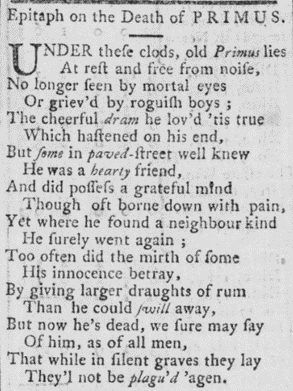
The New Hampshire Gazette played an essential role in the political discourse of the Revolutionary Era. It was the first colonial newspaper to print the words of Samuel Adams, and in 1765 protested the Stamp Act by publishing the October 31, 1765 edition surrounded by black borders.
Among the Clouds began its forty-year run in 1877 and ended with the outbreak of World War I. The paper’s publication coincided with the growth of White Mountains tourism. Its primary readers were the tourists who flocked to the area following the development of railroads and hotels. Among the Clouds documents the rise of mountain escapism in the Gilded Age, demonstrating the radically shifting land-use patterns that preceded the turn of the century.
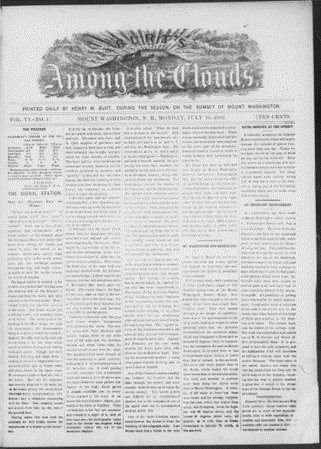
What have you learned about these newspapers through the process of digitization?
From our vantage, it’s easy to think of history as predefined and knowable. However, in reading these papers, we were confronted with how alive and contested each documented moment was. In our daily work preparing microfilm for digitization and reviewing data from our vendors, we encountered the contradictions rife throughout American history. In the April 21, 1775 issue of the New Hampshire Gazette, the news included violent skirmishes in Lexington and Concord that foretold the American Revolutionary War and, several pages later, an advertisement for an enslaved Black woman “to be sold very cheap.”
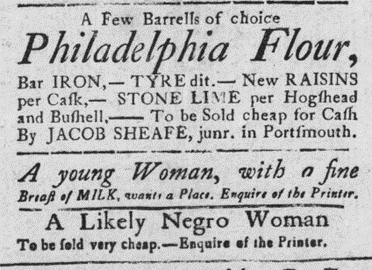
In another paper, Foster’s Daily Democrat, there are numerous ads throughout the 1890s for blood purifiers claiming to cure nervousness, sleeplessness, and rheumatism. What we’re seeing is a readership no less health-obsessed than readers today, and in that way, quite familiar to a modern audience. With each turning of the digital page, these papers challenge and complicate dominant narratives of history by offering a window into real daily life.
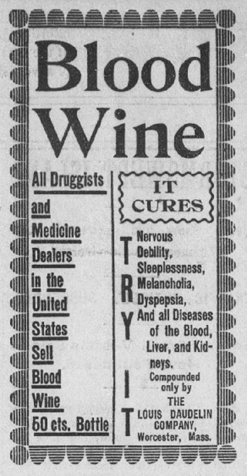
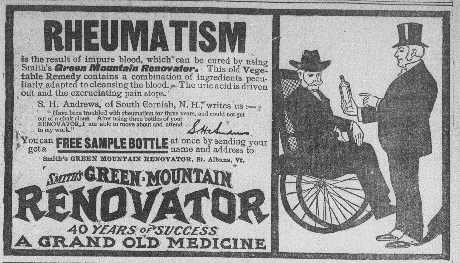
How do you anticipate people will use these newly-digitized newspapers?
We’re excited by all the possible uses for digitized New Hampshire papers – though we can predict some uses, it’ll be interesting to see how people use them! In particular, we’re thrilled to provide access to titles previously only available behind a paywall. Our digitization work enhances access and removes research barriers by making historically significant titles like the New Hampshire Gazette free online. This work has enormous potential to impact K-12 level primary source literacy because any student with an internet connection can access the collection’s wealth of documents. We are also interested in the opportunities for computational text analysis that Chronicling America makes possible.
Is there anything else you would like to share about these newspapers or the New Hampshire newspaper project? Where can readers find you online?
We want to give a shout out to our partners’ work! The New Hampshire State Library houses the bulk of the microfilm reels we digitize for this project. Along with the State Library, the New Hampshire Historical Society and the University of New Hampshire have been incredibly helpful in orienting us to New Hampshire’s newspaper landscape. You can read more about the New Hampshire Digital Newspaper Project at our collection site, where you’ll see the titles we are digitizing, links to those titles in Chronicling America, a title map, and more. We host this project – and other fantastic digital collections – via Digital by Dartmouth Library (DxDL), Dartmouth Libraries’ digitization lab here at Dartmouth College. Check us out!
Search Strategies
To find all the newspapers published in New Hampshire in Chronicling America, go to the “All Digitized Titles” tab, select “New Hampshire” in the “State” dropdown menu, and click “Apply Filters.” This will display the newspaper titles currently available on Chronicling America from the state. At the time of this blog post there are 13 titles, but more will be added, so check back often.
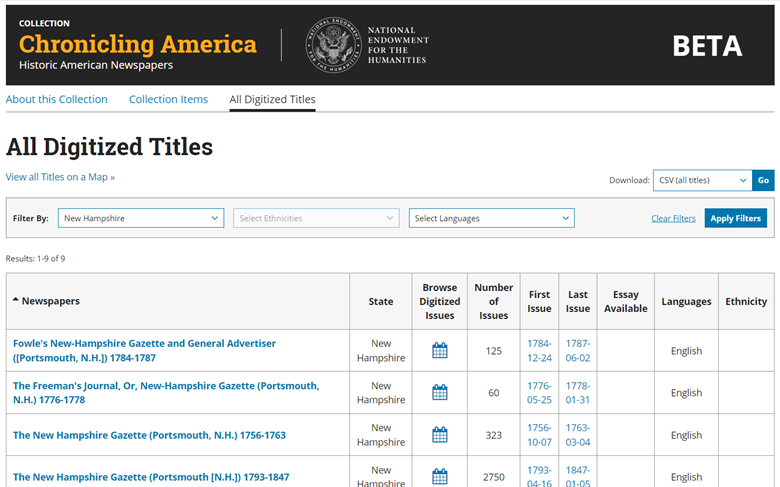
You can then click on a specific title from the list of New Hampshire newspapers, and you will be directed to the title record for that newspaper, which will provide details on publication location (or locations), the publisher, dates of publication, the frequency of publication, and additional information about the title. The state partners also write essays about each of their digitized titles, which provide additional background about the newspaper, its editor(s), the community it served, and any major events or themes that were covered. In the coming months, Dartmouth College will be contributing essays about more of their digitized titles as they continue working on their first NDNP project, so check back as more essays are added.
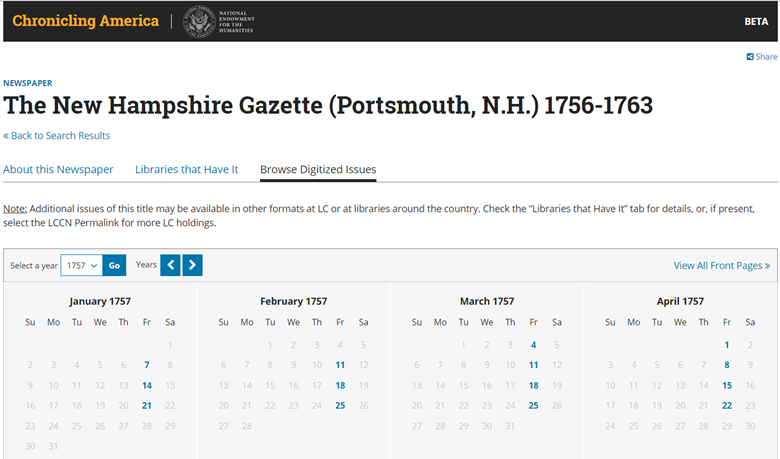
On the “Collection Items” tab, you can use the Advanced Search to search for a keyword search across all New Hampshire newspapers. You can narrow your search by county, city, and title as well.
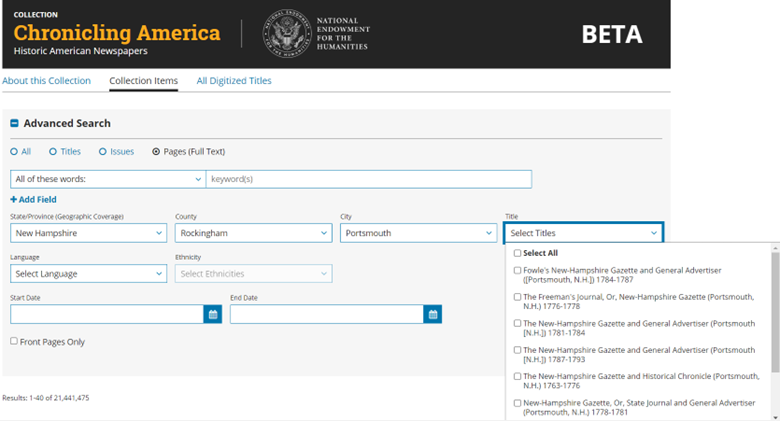
When searching for events or keywords in Chronicling America, it’s helpful to look for historic names, terms, or spellings, that were used during the era in which the newspaper was published. This language may not be used today because historic place names may have changed, or certain wording has fallen out of fashion or is considered racist or insensitive. As you can see in the image below, the early spelling of “authentick” instead of the modern spelling of “authentic.” We suggest browsing the newspapers you are interested in first to discover the type of language being used.
Before 1825, newspapers often used special characters or ligatures in the typeface. Two examples of this include the “long s” and a connected “ct.” The “long s” character looks like a printed “f,” but is actually an “s.” Similarly, the letters “c” and “t” are often connected by a mark, making it difficult for optical character recognition (OCR) software. As you can see in the image below, the word “subject” has been recognized as “fubjed” due to the “long s” being recognized as “f” and the connected “ct” being recognized as a “d” instead. You may need to browse text or use modified keywords that allow for the shortcomings of OCR.
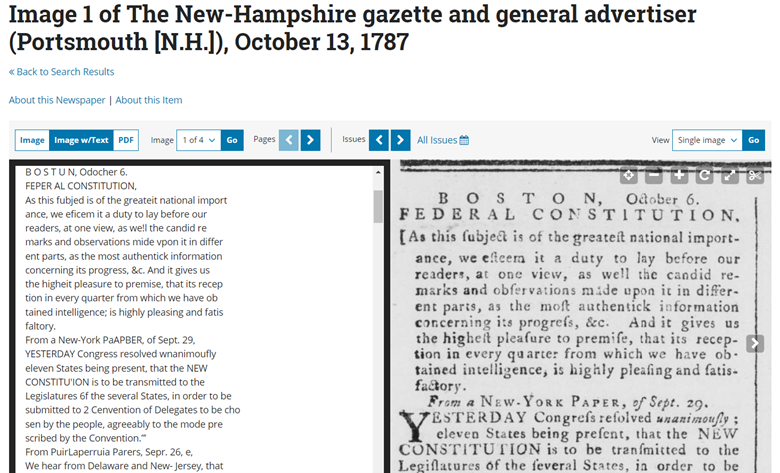
* The Chronicling America historic newspapers online collection is a product of the National Digital Newspaper Program and jointly sponsored by the Library and the National Endowment for the Humanities.
Follow Chronicling America on X @ChronAmLOC
Click here to subscribe to Headlines & Heroes–it’s free!